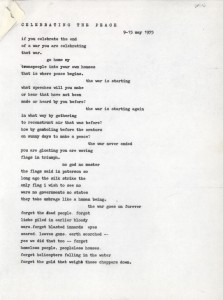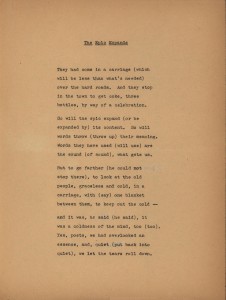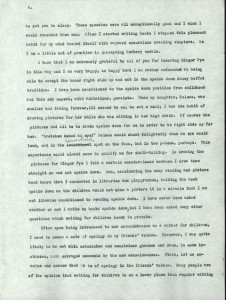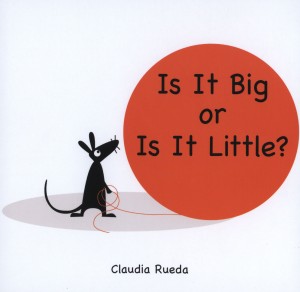
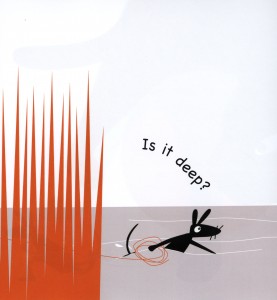 Congratulations to Claudia Rueda, Billie M. Levy Travel Grant recipient in 2009, for the new English translation of her 2011 book “Todos es relativos.” This one is “Is it Big or Is it Little?” and is published by Eerdmans Books for Young Readers. This is a charming book for the youngest readers which compares concepts such as deep and shallow, long and short, and beginning and end. Felicitaciones, Claudia!
Congratulations to Claudia Rueda, Billie M. Levy Travel Grant recipient in 2009, for the new English translation of her 2011 book “Todos es relativos.” This one is “Is it Big or Is it Little?” and is published by Eerdmans Books for Young Readers. This is a charming book for the youngest readers which compares concepts such as deep and shallow, long and short, and beginning and end. Felicitaciones, Claudia!
Author Archives: Jean Cardinale
Insights on a Fellowship
In his third blog installment, Glastonbury teacher and writer David Polochanin, recipient of the James Marshall Fellowship, shares two of his original poems after reading poetry in the Dodd Collection, from the Joel Oppenheimer and Robert Creeley papers.
Blog post 3: On Poetry
“Cartography” and “Celebrating the Peace” by Joel Oppenheimer (Joel Oppenheimer Papers, Box 11, Archives & Special Collections, University of Connecticut Libraries). All rights reserved. No unauthorized reproduction allowed by any means for any reason.
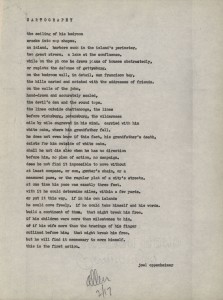
3.20.13
Who would have
thought that
these papers,
with their typewriter
ink fading,
would see the
light of day
again, let alone
on this windy
Wednesday morning
in March?
When the poet
fashioned these words
40 years ago
they were
nothing special,
drafts scattered
in the author’s mind,
printed in a cluttered office,
gathering on the shelf
and the desk top,
in piles on the floor
against the wall,
and others in a stack
on the sill
beside a cactus.
The plant
(and the author)
have long since died
but today
I open a manila
folder and the poetry
comes alive, quite
a miracle, actually.
His words of reflection
and longing, poems
commemorating seasons,
and scenes
in New York City
that the poet likely
saw each day, planes
rising above the
Financial District,
papers blowing
on the sidewalk,
a bird that spent half
its morning jumping
from branch to branch
in a single tree
as a stream of taxis
formed one line
from here
to Central Park,
all of them turning at once,
then disappearing on
behind a monument
when I close this folder
and open the next.
“The Epic Expands” by Robert Creeley (Robert Creeley Papers, Box 2:Folder 48, Archives & Special Collections, University of Connecticut Libraries). All rights reserved. No unauthorized reproduction allowed by any means for any reason.
Sipping A Coke
Back when I was a kid
we used to sit on a porch
and sip Coke.
The parents sat in
rocking chairs,
holding their drink
in a bottle;
the young ones sat
on the concrete steps
flicking with their non-
drinking hand
the tiniest of pebbles
and the sun sat
motionless
in the sky.
We sipped it together.
We sipped it because
it was good. People
didn’t die because
of soft drinks, then.
No one developed
an addiction to caffeine
and diabetes
wasn’t a problem.
Having this drink allowed
us to chat about life,
about the dog’s laziness,
how the garden
was coming along,
and there was
a baseball game
on the radio
Saturday night.
Yes, those afternoons
had some kind
of timeless element.
I can still taste
the sweet soda
in my mouth
and I wonder
to this day
as I read this poem
what that
is all
about.
Insight on a Fellowship
For the 2012-2013 academic year, Glastonbury teacher and writer David Polochanin was awarded the James Marshall Fellowship while on sabbatical to research the archives at the Northeast Children’s Literature Collection and create young adult poetry and fiction of his own. This is the last in a series of blog installments on his insights, observations, and discoveries.
Blog post 4: On Natalie Babbitt’s Tuck Everlasting, and Some Final Thoughts On My Fellowship
“Tuck Everlasting is a fearsome and beautifully written book that can’t be put down or forgotten… I esteem it as a work or art, but it makes me as nervous as a cat. If I were twelve, on the other hand, I would love it.”
– Jean Stafford, The New Yorker, 1975
“It’s almost impossible to pick one book that speaks to all the needs, dreams, desires of children in these years of the Search for Self. But if we were to choose one book for a ten to twelve- year-old stranded on that proverbial desert island, it would probably be Tuck Everlasting by Natalie Babbitt.”
– From Choosing Books for Kids: Choosing the Right Book For the Right Child At The Right Time (Ballantine Books, 1986)
Unless you’re a researcher, author, or interested in the inner workings of the writing craft, it is likely that, when reading a new book, with its glossy cover and crisp new pages, you will never know the labor involved in writing it. That’s not what draws people toward reading literature, usually. You might read a review on amazon.com or in a newspaper. You may get a recommendation from a friend, or read a blurb on a back cover in a bookstore.
It’s also likely that few readers probably care about that process – the multiple drafts, the dead-ends, the outlines, the correspondence with agents and editors – in general, the ‘messiness’ that goes along with writing a book. After all, there are a select few who have the ambition to write a book, even fewer who pull it off, and fewer still who get their books published. Most readers, I submit, read for entertainment, not to study the writing process.
Good thing for me that I like to do that.
When examining drafts of Natalie Babbitt’s Tuck Everlasting, the 1975 masterwork of children’s literature often listed on all-time best-books-for-children lists, it became immediately clear that her process was not easy or quick. It wasn’t a masterpiece the first time around. There are three drafts included in the collection, and the first two are thoroughly edited, with numerous cross-outs, inserts, writing all over the top, side, and bottom margins, places where new paragraphs need to be inserted, arrows drawn from here to there. Whether it’s a change from “said” to “whispered”, changing a reference from a character’s name to a pronoun reference, the elimination of how a chapter would begin, the manuscript is marked up – in a good way. When I flipped through the manuscript’s first draft, not one page was left alone.
Click here for an example of Natalie Babbitt’s revision process.
One powerful example of this is at the end of Chapter 22, where Babbitt adds this dramatic, skillful ending in handwritten script in the bottom and side margins. The cross-outs are Ms. Babbitt’s.
Mae had killed the man in the yellow suit. And she had meant to kill him…
Winnie had killed a wasp once, in fear and anger, just as it in time to spare herself a stinging. She had slammed at the wasp with a heavy book, and killed it. And then, at once, seeing its body broken, the thin wings stilled, she had at once wished it were alive again. She had wept for that wasp. Was Mae weeping now for the man in the yellow suit? In spite of her wish to spare the world, did she wish he were alive again? There was no way of knowing. But Mae had done what she thought she had to do. Winnie closed her eyes to shut out the silent pulse of the lightning.
I don’t know about you, but when I see examples of revision like that – which eventually became a permanent part of the story – I get chills. To know that paragraph was not in Ms. Babbitt’s mind when initially composing the first draft speaks volumes about the importance of revising, and why writers must revise if they are to push themselves to write their best work.
Here is another deft example of Babbitt’s revision, her first draft of the opening paragraph to chapter 25, which came to be the first paragraph of Chapter 23. Again, the cross-throughs are Babbitt’s.
It was the longest day: mindlessly hot, unspeakably hot, a cruel punishment to a guiltless world for unknown too hot to move, or even think. The countryside, the village of Treegap, the wood, motionless all lay whipped and helpless gasping. The sun was a ponderous circle without edges, a roar without a sound, a blazingglare blaze so thorough consuming that even Queen Anne’s lace cast perfect, motionless shadows and remorseless that even in the Foster’s parlor, with curtains drawn, it seemed an actual tangible presence. You could not shut it out.
In her second draft, this paragraph evolved to:
It was the longest day: mindlessly hot, unspeakably hot, too hot to move or even think. The countryside, the village of Treegap, the wood – all lay defeated whipped and beaten. Nothing stirred. The sun was a ponderous circle without edges, a roar without a sound, a blazing glare so thorough and remorseless that even in the Fosters’ parlor, with curtains drawn, it seemed an actual presence.You could not shut it out.
Notice how her language tightens. The text does not become spare – Babbitt’s prose is too descriptive and rich to be spare – but words and phrases are eliminated, and the writing is better for it.
What I wonder about, as a teacher, as a writer, is this: Do student writers know this about writing? Do they know that this is a normal part of a writer’s process? That even the drafts of some of the greatest masterworks of children’s literature were not polished or complete in the first draft, or even the second draft?
Would it help for them to see this? I believe so. As a freelance writer, poet, and former journalist myself, I derived an education – and also inspiration – from reading through Babbitt’s drafts and witnessing her process.
A few other interesting things caught my attention as I read through the three drafts. First, the lead character, Winnie, was originally not named Winnie. She was Daisy. Only after chapter 10 of her second draft did Babbitt change her name. Also, the title of the book, etched in the minds of children and adults alike, was not a certain thing. During the process, Babbitt brainstormed various titles, including: The Ripe Old Age Of Always, Ancient, An Ancient Tender Age, Daisy and Forever, and Tuck Everlasting.
I wondered why these changes were made – with these and several other questions. There are sometimes limitations when reading through archival materials, so I thought the only way to get the answers was to ask Natalie Babbitt herself.
Five days after sending her a list of my questions, Ms. Babbitt graciously and generously responded. Her responses provide insights about Tuck, her personal writing process, and she even revealed what, to her, is the finest piece of children’s literature.
Here is the entire, unedited transcript of my questions and her answers. I chose not to shorten it because her responses are simply too good to edit.
1. I noticed [in your notes] that there appeared to be a list of potential titles for this book, including:
The Ripe Old Age Of Always Daisy And Forever
Ancient Tuck Everlasting
An Ancient Tender Age
How did you ultimately arrive at Tuck Everlasting? Was it your decision or an editor’s? Do you recall what you were thinking while going through this process? And, do you think the title is especially important for this book, or if the book would have succeeded had you named it something else?
I want to start by saying there are no rules for writing stories, once you get past grammar and punctuation. Everyone has systems of their own. I think choosing a title is one of the most difficult extras. But finally, for me, anyway, a title comes to the head of the list because, whether the writer knows it or not, it should say best what needs saying: it tells something about the story it represents, but not too much – and it needs to have an almost musical rhythm to it. My editor, without whom I’d never have written a word, has never demanded one title or another – he leaves it up to me – but if he dislikes the sound of a title, or its seeming meaning, he’ll say so. But I doubt if a given title would make a success of a story, good, bad, or indifferent. Leaning on any part of a story – except the story itself – to create success spells disaster.
2. I noticed in the first draft and through Chapter 10 of the second draft that the lead character was named Daisy. Can you tell me why you made the change to Winnie? Also, it looked like she was possibly named Anna in one of the drafts. Can you comment on why you changed her name and if you had changed characters’ names in other books you have written while in the process of writing?
The name of my main character in Tuck was changed a number of times because, first, I wanted a name that was popular at the time the story takes place, and second, I wanted to find a name that, for me sounded serious – not cute; a name representative (for me) of the character’s personality. “Daisy” began to annoy me. Since then, mostly, I choose names very carefully while I’m planning a story. “Winnie”, as you know now, is a nickname for “Winifred”, and both can be used here to good effect. I think.
3. About the process… did you realize you were writing something extraordinary/special as you were composing Tuck? If so, when, and how did this impact your writing?
Did I realize I was writing something extraordinary when I was writing Tuck? Not in the least. In fact, I was pretty sure the theme had already been used many times. It still surprises me that it was fairly unique. But I can tell you that many adults, when I told them what the basic theme of the story was going to be, were horrified. “Write about death for children? That’s a terrible idea! They won’t understand that! It will only scare them!” Wrong! Completely wrong! I have had wonderful, articulate letters from thoughtful, philosophizing (if that’s a word) children steadily throughout the years since it appeared. It is mainly to the credit of reading teachers that it has been used in schools, bless them. But the children understand it by themselves, and have a lot to say about it. I wish this society would stop thinking that everyone under the age of seventeen is useless and dumb.
4. I noticed that your first draft was in longhand. Is that how you typically start to write? If so, why do you feel that method works for you?
My first draft was in longhand because, in the 70s, computers were not commonplace. I wrote in longhand, and then typed it all on my typewriter, chapter by chapter, as I went along. It’s what everyone did, so far as I know.
5. Can you comment on the writing process of this book? Did the writing happen more quickly or slowly than usual? Do you recall how long it took to write the 1st draft, to finish the second draft, and complete the third?
I don’t know if I ever had a writing process exactly. I never began a story (on paper) until I knew what it was that I wanted to say, and how the story would end. I have never begun a story without knowing what the ending will be. And, as far as I’m concerned, every story should have a purpose. But you have to be really careful not to preach. Some stories come easily because their purpose is clear from the beginning. But my latest story, The Moon Over High Street, took ten years to become a real book. In the beginning, it was terrible, and I kept throwing most of it away. But I think it works all right now that it’s complete.
6. Why do you think, in this age of fickle, and sometimes odd, tastes in children’s literature, that Tuck has endured all these years? Any theories?
I think Tuck has lasted because, no matter how many years go by, the question of death, and how to live with it, never goes away. What you call ‘odd’ and ‘fickle’ about tastes in children’s literature are aspects that do not come from the young readers themselves. They come mostly from writers – and illustrators – who are trying to become established. Nothing wrong with that. But I think the best themes come from the people who remember what it was really like to be a child. My childhood is very clear and distinct to me. In fact, I think my whole philosophy was created before I was ten years old, and it has never changed. This doesn’t mean that I think my books are special in any way – after all, I started out wanting to be an illustrator – but at least they’re honest, and, I hope, direct.
7. I noticed that you had a good deal of notes and outlining, including a chronology, as part of your manuscript. Is this typical for you? If so, why do you feel that’s an important part of your process? Does it make the writing any easier?
Click here for Natalie Babbitt’s handwritten chronology for Tuck Everlasting.
Yes, I take a lot of notes and do a lot of research, and think and plan endlessly. I can’t start writing until the story has a shape and a purpose (for me) and a good ending. Not happy, necessarily, but rational and reasonable.
8. Your first two drafts include many revisions, cross-outs, arrows all over the margins, etc. As a teacher and a writer, it was excellent to see the, for lack of a better word, ‘messiness’, of this process. What is your revision process like? Do you read your work aloud? Do you have other readers you count on for feedback? It seemed that some of these revisions were revelatory and substantial. Do you expect to make significant changes when revising, or are you surprised by them?
My drafts now are a lot tidier than they used to be. Computers are a great help. But there have been lots and lots of cross-outs and arrows in my head. And that’s where the revisions try themselves out. I think about a new story endlessly, and completely stop reading anything else until there’s room in my head once again. No, I don’t read my work aloud except when I have a few beginning pages. Then, sometimes, I send a few paragraphs to my editor (his name is Michael di Capua, and we’ve been together for more than 45 years). He is very candid in his reactions, and I treasure them. But I don’t think I’ve ever read anything aloud to my husband. He’s got a PhD in American Studies, with a specialization in American literature, and that aspects usually scares me. Mostly, he reads my books when they’re published.
9. What are a few of what you believe to be the finest examples of children’s literature, all-time? A Natalie Babbitt Top 5 or Top 10?
The finest example of children’s literature is, to me, Alice in Wonderland. I read it first when I was in fourth grade and it has formed a lot of different pieces of my taste and philosophy. The language is wonderful, and Alice herself is the only character in the book that has a particle of sense. It tells the truth, and it tells it with objectivity and humor and shows again and again what adults are really about.
. . .
On a closing note, back in December when I began this fellowship, when I discovered that Tuck Everlasting was in the NCLC collection, I decided that I wanted to write my final blog post about this book. That, along with Natalie Babbitt’s thoughtful and revealing responses, makes me feel as though I made the right decision. For me, anyway. There could have been any number of paths that this fellowship took; there are hundreds of boxes of material that I did not explore. But I do want to recognize and thank the NCLC curator Terri Goldich for allowing me tremendous latitude in what I did, and for her support along the way. Thanks, also, to the other curators and Dodd Center staff, including Betsy Pittman, for accommodating my requests and answering my questions. I’m going to miss this place.
This fellowship was an unexpected, yet significant part of a sabbatical in which I have mainly written young adult poetry – I have a collection of poems that I am currently pitching to agents and editors – and a collection of short stories that I am planning to polish and revise in the next few weeks. I am grateful to the Glastonbury School District, its Board of Education, Superintendent of Schools Alan Bookman, my principal at Gideon Welles School, Jay Gregorski, and the Director of Reading and Language Arts, Joanne St. Peter, for supporting this sabbatical. What an unparalleled professional development opportunity. I learned a lot about myself as a writer and a teacher and look forward to returning to the classroom in the fall.
I think it’s appropriate to finish this post with Natalie Babbitt’s last words to me in her letter, when she puts her writing process simply, perhaps deceptively so.
What it comes down to, for me, is: you have to have something to say, and you have to like words. And that’s about it.
Insights on a Fellowship
Glastonbury, Conn., English teacher David Polochanin was recently awarded the James Marshall Fellowship, as he pursues to write young adult literature as part of a yearlong sabbatical. During his research, he will write an occasional series of blog posts, based on his observations and insights relating to the contents of the Northeast Children’s Literature Collection at the University of Connecticut. This is the second in the series.
Blog post 2: On The Psychology Of Writing
“You may think that this is the first Newbery acceptance speech I have ever made. But it isn’t. Long ago, before I ever wrote a book, when I was a children’s librarian and first aware of the Newbery Medal, I used to often put myself to sleep at night making speeches accepting this coveted award. These speeches were all exceptionally good and I wish I could remember them now. After I started writing, I stopped this pleasant habit, for my mind busied itself with wayward excursions creating chapters for… books.”
Excerpt from Eleanor Estes’ 1952 Newbery Medal speech for her book Ginger Pye
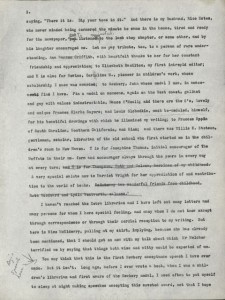
Within the publishing industry, there is a genre subset that exists mainly because of the uncertainty, mystery, and pressure that all writers face – the self-help writing guide. New books are sold every year, offering expert advice on such writerly, often impossible, things as how to summon the muses, where characters come from, the best ways to begin and end a story, if outlining is necessary for everyone, as if these were insider secrets only known to a few. Still, we learn that some authors write early in morning; others late at night. Some claim the best ideas come while taking long walks; others write what they dream and form stories around that.
To prove the marketability of such books, there is still a shelf at your local Barnes and Noble and the UConn Co-op reserved for such titles as John Gardner’s The Art of Fiction, Ray Bradbury’s Zen In The Art Of Writing, Stephen King’s On Writing: A Memoir Of The Craft, Natalie Goldberg’s Writing Down the Bones: Freeing The Writer Within, Anne Lamott’s Bird By Bird: Some Instructions on Writing and Life, and Strunk and White’s The Elements of Style, among others.
As a writer, especially at the beginning, during those fledgling phases when you’ve got 40 pages of something and it isn’t going so well, it’s hard not to look at these books. They are indeed tempting to read. Teachers at the college level routinely assign them as class texts, and the content is often useful, if not entertaining. I’ve bought a bunch of them myself, and every now and then, I return to them for inspiration or direction.
So, what makes me bring up the self-help industry for writers? A progressive-minded document from 1952.
Browsing through the Eleanor Estes papers recently I came upon several drafts of her Newbery Medal speech, given in 1952 for her book Ginger Pye, which stopped me in my tracks. As I read the draft, complete with cross-outs and edits, I stopped at the excerpt at the top of this post and had to reread it. I copied it verbatim on my yellow legal pad. Estes, a former librarian in New York City, said this was not her first speech. She had given many of them, in her head, putting herself to sleep at night imagining that she had won the award. What she was saying could have easily been included in a how-to-write guide; it still could.
With so much written about the psychology of writing – directly or indirectly – the truth remains elusive. What works for some will not work for all. I know for a fact that I do not have the motivation to write at 4:30 a.m., as some writers do. My most productive work time is sometime between 10 a.m. and 2 p.m. It used to be from 9 p.m. to midnight, before my kids entered the picture. I have had numerous ideas come to me while on bike rides and while driving my car, though I would hesitate to say there is a direct correlation between generating writing ideas and movement. Perhaps through doing these activities, my mind has an opportunity to clear out some space for creative thought. But who really knows.
Reading from superior examples in the genre you’re writing seems to help warm up the brain. Perhaps it’s nothing more than mere imitation. But is this scientifically based? I doubt it, or know if it can be. Still, Ted Kooser, the Pulitzer Prize winning poet who has been the U.S. Poet Laureate, in interviews says he has done this, as have many other writers. When I was a journalist at the Providence Journal, before a major assignment an editor once sent me a handful of front-page feature stories from the Wall Street Journal before I started to write one of my own. I did “channel” something from those stories, but I think I was too young to figure out how the articles she sent could help me.
Nevertheless, I guess the Estes comment surprised me because of the time period in which she wrote it, and also because it still makes so much sense today. How could it not help to imagine doing the very thing you want to do? Isn’t visualization/imagery the most primitive version of positive psychology? Estes was priming her brain to write great works, and her nightly fantasizing ritual ultimately gave her a tight focus and, quite likely, a motivation.
It worked for her. Could it work for others?
Sifting through boxes of manuscripts in the Northeast Children’s Literature Collection, I suppose, can have a similar effect: to gain a psychological edge in the writing process. It’s easy to forget sometimes that writing is truly an art form, and that artists need inspiration and particular conditions in order to do it well. Whether it’s writing near the window at Starbucks, which seems to be a favorite for many, or in a secluded study room at a library, I’m not sure if there are any big secrets that will work for everyone. The trick, I think, is discovering what will work for you.
“Timmy Trapped on Mars”: What Makes Failed Pitches “Bad”? by Tanya Rose Lane
For almost two years, I have been blessed with the incredible opportunity to work under Terri Goldich, the curator for the Northeast Children’s Literature Collection located in the Thomas J. Dodd Research Center. That’s right– not only do I get to work hands-on with sketches, dummies, and correspondence from children’s authors and illustrators but I also get paid for it! My most interesting assignment, by far, has been performing the box inventory and description for the Mo Willems Papers. Hailing from New Orleans and a graduate of NYU’s Tisch School of the Arts, Mo Willems is a wildly successful children’s author, illustrator, animator, and Caldecott Medal recipient. With animation credits that include Sesame Street, shows on both Nickelodeon and Cartoon Network, plus the popular Pigeon book series, it is hard to believe that Mo Willems has entire boxes within his collection here dedicated to failed pitches. Why did some of Mo’s seemingly most fun and interesting ideas get rejected by editors and animation networks? But, alas, there must be reasons why some artists’ creative ideas never quite come to life and I set out to investigate those reasons.
The possible answer to my question lies within an overcrowded box deep within the shadows of the stacks (let me just note that, as a library assistant, the storage technique authors often use of stuffing every document they’ve ever owned into boxes that won’t hold all of them is both irritating and humorous). After I managed to yank the folder entitled “Failed Pitches” out of one of Mo’s boxes, I came across an interesting set of sketches and animation designs that were clearly from the beginning stages of an animated T.V. show. The show in question, “Timmy Trapped on Mars” was an idea that Mo pitched in 1998. The plot is essentially this: while on a walk through his suburban neighborhood, Timmy and his pet goldfish are abducted by a passing UFO. When taken to Mars, the aliens there identify Timmy’s fish Cleveland as a superior being. Cleveland soon is out to get Timmy for drowning him and feeding him nasty flakes daily while on planet Earth. Timmy’s only new friend, Bubba, is his guide while he is trapped on Mars.
Artwork and animation: Willems, Mo. “Timmy Trapped on Mars”. May 1998. Mo Willems Papers, Box #4, “Failed Pitches”. Archives and Special Collections at the Thomas J. Dodd Research Center. All rights reserved. No reproduction of any kind allowed.
When I went through Mo’s notes that accompanied his artwork, I soon saw how he tried to identify possible aspects of the animated show that might not have “worked” with networks. It seems that in order to get the green light on this T.V. show, Mo would have had to find a way to have Timmy act as an active protagonist instead of a sad main character constantly “pining” for planet Earth. He would also need to find a way to make the main dynamic of Cleveland vs. Timmy interesting and turn their relationship into one that is more complicated and complex. In his notes, Mo mentioned that he wanted to explore the role reversal with the fish as the ruler and the boy as a pet. This is where I think things could have gotten complicated and potentially unattractive to television networks. Mo Willems is known for his dark, satirical work where he satirizes adult authority and rules, something that definitely works in projects like the Pigeon books. However, the idea of role reversal here and challenging rules might not have gone over well with T.V. producers. The outer space setting also brings attention to another topic wrought with tension, that being the environment. By going to outer space and switching things up, Timmy’s situation makes me think, at least as an adult, that perhaps we earthlings are the ones who have things backwards. All of this might have been viewed as too political for an animated show for children or, maybe, producers just thought the plot had no lasting power. Maybe there were too many animated shows in 1998 about outer space or goldfish; it could have been absolutely anything. What do you think?
Insights on a Fellowship
Glastonbury, Conn., English teacher David Polochanin was recently awarded the James Marshall Fellowship, as he pursues to write young adult literature as part of a yearlong sabbatical. During his research, he will write an occasional series of blog posts, based on his observations and insights relating to the contents of the Northeast Children’s Literature Collection at the University of Connecticut. Polochanin’s work has been widely published in major newspapers in New England, including The Boston Globe, Providence Journal, and Hartford Courant. His education writing has appeared in Education Week and Middle Ground, and his poetry has been included in an anthology by Native West Press, and will be published in the prose poetry journal Sentence.
Blog Post 1: On Production
Combing through the archives of this collection has been fascinating, and an extraordinary opportunity. Since my days as a reporting intern for the Boston Globe nearly 20 years ago, I’ve been interested in authors’ behind-the-scenes writing process – perhaps because the art of creation is typically so mysterious. After all, when authors are interviewed by admirers, one of the first questions they are asked is, “How did you write this?” or “Where did the idea come from?”
I am not so much interested in where ideas come from, but I am intrigued with the process of writing itself.
In a way, I am learning that it is not so complicated.
While I have examined only a fraction of what the Northeast Children’s Literature Collection holds, I am struck by the sheer production of some of these authors, the volume of work they have created, and that, it would seem, an author’s ability and determination to produce such large amounts of work are major factors leading to publication, success, accolades, fame. This drive ultimately distinguishes a recreational writer, I think, from writers who earn a living by writing, particularly as a creative writer, for adults and children alike.
Their success is not reliant upon talent, alone.
It takes tenacity to produce. I am reminded of an interview I read recently with Newbery Medal winning author Kate DiCamillo, posted on the website ReadingRockets.org. She said, “I’ve been in so many writing workshops, writing classes, and to the right of me and to the left of me, there’s always somebody much more talented than I am. And what I figured out is they’re not willing to go through the rejection, which is enormous, and then the compromise that comes with editing your work. I decided a long time ago that I didn’t have to be talented. I just had to be persistent, and that that was something that I could control — the persistence. I’ve always been kind of persistent.”
Again and again in author interviews, this is a common refrain. In order to publish your work, one must work hard. Sounds simple. But the determination involved when there are dozens of things vying for our time, is remarkable. It means casting these distractions – the Internet, TV, the laundry, the long shower – aside to sit somewhere and write for extended periods of time. In today’s society, a place where patience is underrated, this kind of discipline is increasingly difficult.
So when I look through boxes of drafts, notes, and manuscripts by such celebrated children’s authors as Eleanor Estes and Ruth Krauss, whose works are well represented in the Northeast Children’s Literature Collection, seeing the sheer amount of their work stacked in box after box on the shelves in the back room, you begin to get a sense of why these are noteworthy writers and why their work is housed in a university archive.
Writing is a way of life. And you can tell that many of the writers here have dedicated their lives to the craft, to creating stories, poetry, or nonfiction. They have been prolific producers. It’s not unlike any other line of work that requires intense focus and discipline in order to rise to the top of a profession. The best physicians are often board-certified, keep up with current research, and teach young doctors in training; the best NBA players spend hours beyond their usual practice and game time to practice three-pointers and free throws and watch video of their games.
‘Consuming’ is the right word to describe this sort of dedication.
In his book The Outliers, author Malcolm Gladwell theorizes that it takes 10,000 hours to become an expert at a craft, including reaching the highest levels of achievement in business, technology, sports, and music. I’d argue the same goes for writing. Over 10 years, that’s 1,000 hours a year, or 83 hours a month, 19 hours a week, or about three hours a day. Of course, this is provided that you write every day.
Poring through this collection’s files and folders and the sheer volume of production included here makes it clear, at least in my mind: the more a writer produces, the more likely they are to get published, and the more likely one is to eventually publish work of enduring value. Kate DiCamillo has it right: First comes a stubborn persistence, then comes talent.
ALA Awards go to several CT Children’s Book Fair folks and one NCLC donor!
Congratulations to several of our CT Children’s Book Fair folks for their prestigious awards at ALA this morning!
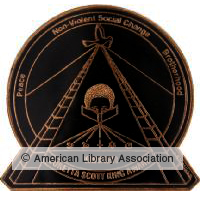 E. B. Lewis, Coretta Scott King Honor Book for Each Kindness and Bryan Collier, Coretta Scott King Illustrator for I, Too, am America;
E. B. Lewis, Coretta Scott King Honor Book for Each Kindness and Bryan Collier, Coretta Scott King Illustrator for I, Too, am America;
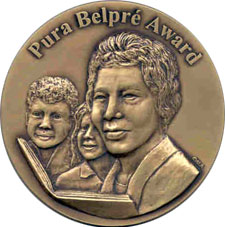 Sonia Manzano, Pura Belpre Honor Book for The Revolution of Evelyn Serrano;
Sonia Manzano, Pura Belpre Honor Book for The Revolution of Evelyn Serrano;
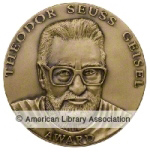 Mo Willems, NCLC donor, Geisel Honor for Let’s Go for a Drive ;
Mo Willems, NCLC donor, Geisel Honor for Let’s Go for a Drive ;
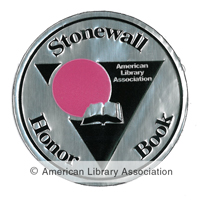 and Leslea Newman, Stonewall Honor Book for October Mourning.
and Leslea Newman, Stonewall Honor Book for October Mourning.
Katie Davis exhibit
[slideshow_deploy id=’730′]The Katie Davis exhibit in the Dodd Research Center Gallery will be coming down on February 22, 2013, in the early morning. So if you haven’t seen it yet, you’ll want to come in soon. It’s a wonderful exhibit documenting Katie’s creative process. And, trust me, is she ever creative.
Susan Raab’s latest artstomarket blog on digital technology
Check out Susan’s blog about the Pew Research Center’s Internet & American Life Project report on the impact digital technology and social media have on the arts in America. Over 1200 NEA grantees participated in an online survey. The report investigates the many uses of technology in the arts world and identifies challenges organizations face in difficult economic times.
Gerald McDermott
The world of children’s literature has lost another star. Gerald McDermott died on December 26, 2012, at the age of 71. Mr. McDermott created folklore films and wrote and illustrated picture books, including Anansi the Spider: A Tale from Ashanti (1972) and Raven: A Trickster Tale from the Pacific Northwest (1993), both of which received Caldecott Honors. He received the 1975 Caldecott Medal for Arrow to the Sun: A Tale from the Pueblo. For more information on his amazing life and work, see his site at http://www.geraldmcdermott.com/ . Mr. McDermott was a student at Pratt and studied with our own Roger Crossgrove. Our condolences to his family and friends.

